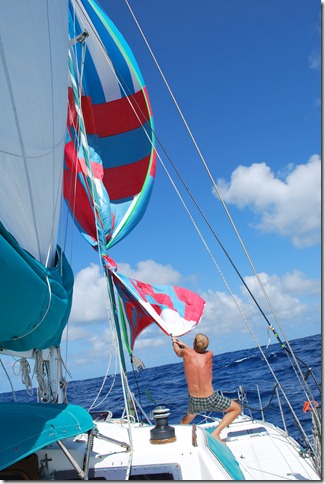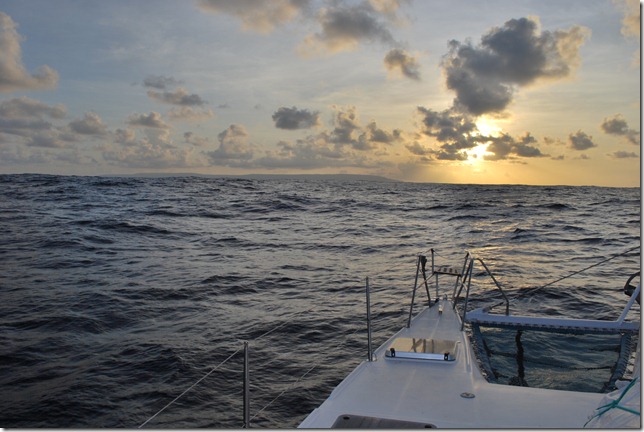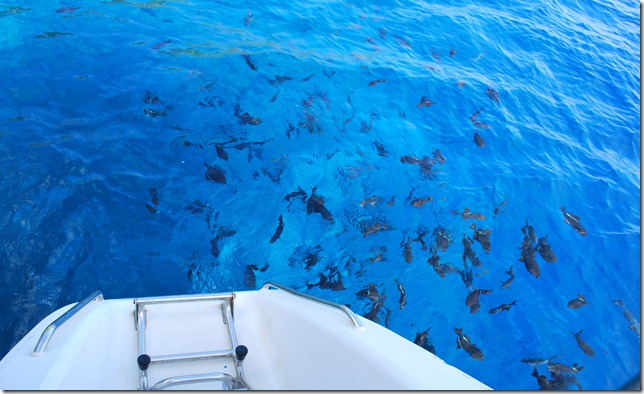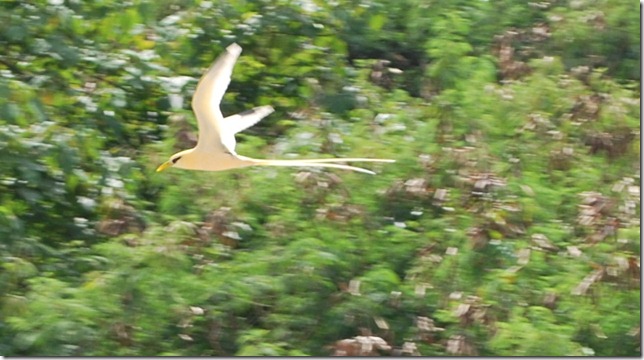The last couple of days into Christmas Island were looking like they were going to be uneventful. The spinnaker conditions continued, and by Thursday morning it looked like we were going to be in by sunset if we could just keep up 6 knots. That’s usually fairly fast for us, but in the trades with a favorable current, we’d been making good time. Unfortunately, the wind started to die down a bit and left us with only about 5 knots. No problem. We decided to just put the main up in addition to the spinnaker. That’s pretty common on a monohull, but on a cat, the cap shrouds keep the boom from swinging very far out, so we usually don’t bother with it. It all went great for the first hour or so, and then I looked out through the hatch in the salon and saw the spinnaker stalled and starting to wrap around the forestay. By time I got out to the foredeck it was too late. All I could really do was watch the spinnaker keep wrapping itself around the forestay as the wind swirled off of the main. We eventually dropped the main to stop the funny wind eddies, but it didn’t help free the spinnaker. It was wrapped at the top and bottom, just out of arms reach, and the middle was filled with wind, holding it tight. After several failed attempts to pull it loose (it was wrapped so tight that even loosening the halyard did nothing), we finally started the engine did the only thing that seemed to work – motor in circles in the opposite direction and let the wind unwrap it. That worked like a charm until it came to the last wrap or two, when enough of the spinnaker had come unwrapped that it just started getting caught on the spreaders and mast instead of unwrapping. We finally untied both sheets and then manually unwrapped the last couple of turns before dropping the spinnaker on the tramp. The sock has a couple of tears, but other than that, it seems to be OK. Just as I was trying to untangle the whole mess piled in the trampoline and still tied around the forestay, an Australian customs plane buzzed us. Lauren provided the standard info over the radio, while I was hoping that they didn’t know anything about sailing.
 Let’s just say I didn’t win that round
Let’s just say I didn’t win that round
We motorsailed the rest of the way in and entered Flying Fish Cove a couple of hours after sunset. The water is so deep here that the depth sounder, which only works down to about 400 feet, didn’t register anything until we were nearly a stone’s throw away from the waves crashing on the cliff at the southwestern edge of the cove. Using a spotlight, we were able to find a mooring and get tied up securely with the rocky cliff less than 100 feet away.
 Closing in on Christmas Island at sunset
Closing in on Christmas Island at sunset
When we woke up we looked around to find ourselves in a cove that was beautiful even with the phosphate loading apparatus that takes up a fair part of the shoreline on the eastern side of the bay. Beautiful white and yellow birds with long tails floated above the boat with many more resting in the treetops on the steep hillside towering above the bay. The water below us was so clear that we could easily see the details of the coral more than 20 feet below. Swimming beneath and around the boat was a school of well over 100 Indian Triggerfish that continued to swarm around us when we jumped in for a snorkel. Niue was the last place we visited with such clear water and an underwater topology like this one, where you can snorkel over beautiful, relatively shallow coral with colorful reef fish darting about and then less than 100 yards away look over the edge into the deep blue featureless abyss. As I gazed at the dropoff, I saw several large trumpetfish just floating above the coral, lots of smaller, colorful reef fish, and then a large Napolean Wrasse, as big as the ones on the Great Barrier Reef just rambling along at about 30 feet.
 Large school of Indian Triggerfish at the stern
Large school of Indian Triggerfish at the stern
 A common site at Flying Fish Cove
A common site at Flying Fish Cove
Customs came out after our snorkel and cleared us in during what was probably the most pleasant official visit we’ve had. Islands really do seem to have a nice effect on people. They filled us in on all the social goings on this weekend and gave us some tips on sights to see. We also had a chat about the island’s inhabitants. If my memory is correct, there are about 1200 “locals”, 2400 refugees in a detention camp on the northwest point, and about 600 people working the detention camp. Refugees from boats that are intercepted in the Torres Strait are brought here, and realizing that, some refugee boats come directly here where the passengers are processed and taken in busses to the camp. The boats are then taken 10 miles offshore and destroyed. The refugees are primarily Afghan, Iraqi, Iranian, and Sri Lankan. Apparently many of the Afghan refugees are from the minority Afghan Hazara ethnic group and are now being sent back to Afghanistan. After just reading The Kite Runner on this passage, which includes stories about how the Hazara have been treated in Afghanistan, and hearing about what nice people they are from one of the visiting officers, it’s a little sad to think of them being sent back.
Once cleared in, we had a nice bike around a small portion of the settlement on the northern portion of the island. In many ways, it is a typical small island town – people are friendly, everything is expensive (pizzas were $3-5 in Bali and are $15-20 here in a cafe), the bank has no ATM, but there’s one a shop at the top of the hill, there are two popular pubs, and the internet is agonizingly slow (it could be a long time before we can put up pictures). We had a chat with the a divemaster at one of the two local dive shops and heard some great stories about diving with whale sharks (about 150 were spotted last season) and many other species of large sharks including tigers and hammerheads. He told us to enjoy the wall diving here but to keep an eye on the deep blue as well for the occasional surprise that materializes. Apparently the hammerheads are especially cheeky and shy. They like to get very close to divers to check them out when they aren’t looking, but quickly swim away when you turn to look at them. This is likely to be a short stop for us, but we’re really looking forward to exploring the island and its residents.

